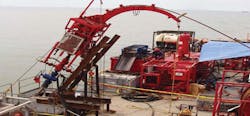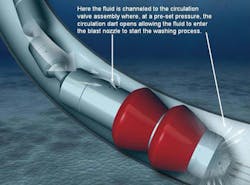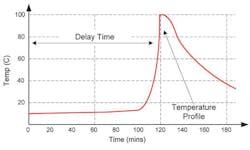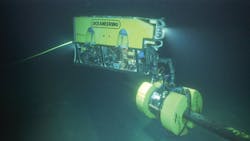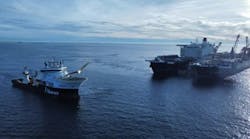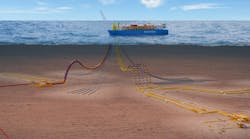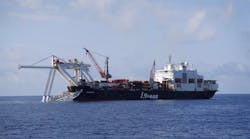New technologies may provide flow assurance alternatives
Filippo Librino
Genesis
In recent years, wax control and remediation have become serious issues in deepwater fields, especially if long tiebacks are involved. Wax reduces the flowline cross sectional area, restricting, and in some case completely impeding, the flow of produced hydrocarbons. This article discusses unconventional wax remediation methods that have been developed to address the situations in which traditional methods are not usable or not effective, along with new techniques to determine the locations of the wax deposits along a flowline and the thickness of the deposits.
Wax consists of long, linear n-paraffin chain normal alkane compounds that are naturally dissolved in crude oil. Wax crystals start to form as the oil cools down and reach the wax appearance temperature (WAT).
Crystals may aggregate in particles that are either transported along with the fluid or, under the appropriate environmental conditions, deposited on pipeline walls, progressively restricting the oil flow and reducing volume produced. WAT changes with the chemical composition of the oil considered.
For prevention, wax is typically controlled by injecting wax inhibitors in the produced fluid, adding insulation layers to the flowlines and running cleaning pigs on a regular basis. However, even with the proper preventive measures in place, flowline wax flow-restricting deposits and even blockages are not uncommon.
Traditional methods
Wax is typically removed using methods including coiled tubing intervention; progressive pigging; and flowline flushing with hot oil, hot water, and various solvents.
The most significant shortcomings of the traditional wax remediation methods are the following:
•Progressive pigging and flowline flushing: Not viable in case of complete flowline blockage
•Progressive pigging: Applicable only to piggable flowlines; potential risk of a full blockage resulting from a stuck pig; considerable flowline downtime
•Solvents: Risks to people and the environment; ineffective at low temperatures encountered in proximity of the seabed (particularly in deepwater); decreased efficiency results in the requirement of large treatment volumes of solvent and long treatment times
•Flushing with hot oil or hot water: Limited reach due to the water/oil cooling; temperature restriction on flexible pipe flowlines that limits effectiveness
•Coiled tubing intervention: Limited reach; may be logistically complex if flowline access on the production facility is difficult.
Unconventional methods
The type of blockage applicability for four unconventional wax remediation methods is shown below. A brief description of each method is provided further down.
CoilTAC
Originally developed by Superior Energy Services Co., CoilTAC significantly extends the reach of coiled tubing. Its equipment consists of a conventional coil tubing unit, control console, various tanks, manifolds, and pumps that are installed on a production facility or a support vessel.
Once access is gained to the obstructed flowline above the sea surface, a device called Thruster, which is equipped with sealing cups, is attached to the end of the coiled tubing and the coiled tubing is started through the flowline. The annulus between the coiled tubing and the flowline is then pressurized to propel the Thruster forward. As a result, the coiled tubing is pulled rather than pushed through the flowline without the risk of helical buckling, causing a significant reach increase. The fluid displaced by the Thruster as it moves forward is sent to the surface through the coiled tubing. The speed at which the Thruster moves through the flowline is controlled by holding back the coiled tubing with the injector.
The Thruster doubles as a cleaning tool. When the propelling fluid pressure exceeds a preset value, internal crossover ports open and allow the fluid to move from the annulus to washing nozzles located at the front of the tool.
If the distance between the blockage and the production facility is greater than the reach of CoilTAC, after cleaning an initial section from the production facility, it will be necessary to cut the line subsea and recover a line-free end to the surface to get coiled tubing access for cleaning a second section.
CoilTAC has been successfully used on a number of wax cleaning jobs in the Gulf of Mexico. The maximum distance for a cleaned blockage has been 20,000 ft (6,096 m).
Flexi-Coil
Flexi-coil was developed by Paradigm Flow Services in 2013. Conceptually, Flexi-Coil is similar to CoilTAC: Coiled tubing is pulled through a flowline using a thruster installed at the end of the coiled tubing by pressurizing the annulus between the flowline and the coiled tubing. An important difference with CoilTAC is that Flexi-Coil uses an almost-neutrally buoyant composite coiled tubing instead of steel coiled tubing. As a result, according to Paradigm, Flexi-Coil is able to negotiate tighter curves in flowlines and risers and achieve longer distances. Paradigm also believes that the chances of composite pipe damaging the flowlines by friction loads applied to the flowline curves are lower than with steel coiled tubing.
Most of the components of the Flexi-Coil surface are smaller than those used with conventional coiled tubing. This makes it easier to install the equipment in the often-limited space offered on production facilities or support vessels.
SureTherm
In the Campos basin, Petrobras pioneered the use of an exothermic chemical reaction between ammonium chloride and sodium nitrite in an acidic pH to generate heat to melt wax (and hydrate) deposits.
In doing so, the Brazilian national oil company successfully removed a number of blockages using the chemical process that is known as the Nitrogen Generating System (SGN, from the Portuguese expression Sistema Gerador de Nitrogênio).
The biggest drawback of the technology was that only those areas in close proximity to the chemical injection point could be treated, because the exothermic reaction would terminate before the chemicals could reach more distant areas.
To address this issue, Halliburton developed SureTherm, which controls the onset of the exothermic chemical reaction and generates heat after a calculated delay time. By delaying the exothermic reaction, sufficient time is available for pumping the chemicals into a flowline to a specified location where the generated heat can be used to treat the wax deposits.
The maximum temperatures achievable and the target temperatures employed are dependent upon and controlled by two factors, namely the pipeline pressure and the concentration of the reactants used.
Depending upon the specific requirements, the SureTherm service can be applied alone or together with solvents. This latter method ensures that the solvents are applied at elevated temperatures, resulting in efficient removal of paraffin from restricted flowlines.
The method can be used online (with production) or offline (flowline shutdown). The increased pressure generated by the produced nitrogen shall be safely released.
To date, SureTherm has been successfully used once in a field trial for one of Halliburton’s clients in West Africa. The SureTherm treatment generated sufficient heat to remove the paraffin deposits in the pipeline; the time-delay mechanism worked as expected; and the reaction took place in the paraffin deposition area.
Pipe-Pulse
Paradigm Flow Services launched Pipe-Pulse in 2011. Pipe-Pulse is targeted at treating fully blocked flowlines. It is based on sending high frequency, low amplitude pressure pulses into the flowline. The length and pressure of a pulse is controlled using the Pipe-Pulse unit and determined by proprietary algorithms developed by Paradigm.
Pipe-Pulse is a non-intrusive technology and does not require support vessels, ROVs, or entering the flowline with coiled tubing. The Pipe-Pulse equipment is installed on the production platform and typically tied to the flowline at the pig launcher.
The pulses work in two different ways: by breaking the bond between the plug and the pipe or by fissuring the plug itself, creating a path for fluid to flow. With the latter, once communication is restored between the two ends of the plug, the pipeline can be flushed with solvent to complete the wax cleaning operations.
The Pipe-Pulse consists of a conventional triplex pump that generates and pressurizes the flowline, usually between 1,000 psi and 2,000 psi (69 bar and 138 bar); a pulse unit capable of generating pressure of various amplitudes and frequency; a hydraulic power unit connected with the pulse unit; and various hoses and valves.
The technology appears particularly attractive for blockages that are located far away from the production platform or other suitable access point, or when significant heat cannot be applied to a temperature restricted flexible pipe flowline.
Potential issues with the technology are the risk of mechanically damaging the flowline, possibly requiring the use of a fatigue analysis. Additionally, high gas content in the flowline, typically defined in excess of 5% of the volume of the flowline, can dampen the pulses.
According to Paradigm, the technology has been used so far in about a dozen projects with a rate of success of 70%.
Determining wax location, deposition
Five techniques by varying companies for determining locations of full or partial blockages are presented here. Tools and methods like these listed below aid in gathering information that can be helpful in determining the best method for wax remediation. In addition, some of these techniques can also be used to diagnose the effectiveness of the remedial treatment after the work is completed.
Halliburton. Pressure Pulse is a non-intrusive surveying method for partial blockages only. Each survey takes a few minutes, and a number of surveys are usually performed on a flowline cleaning job. However, the analysis of the result of a Pressure Pulse survey takes 24-48 hours from the time the survey was performed.
To begin performing the survey, a valve to a flowline, through which fluid is flowing, is rapidly closed. That valve closure creates a pulse (similar to the water hammer effect) that travels through the pipe at the speed of sound. The response from the pulse as it travels along the pipeline is measured with fast sampling pressure transducers and a data logger. The analysis of the response from the pulse is performed; the results of the analysis are presented in a graph showing the estimated thickness of the deposits in millimeters along the flowline. The pressure transducers are usually located close to the actuated valve.
The line volume should be filled with one liquid. Pressure Pulse is not suitable for gas lines. The line should not have more than around 2-3% line volume gas. Flexible sections and interfering pipework such as tees, etc., should be kept to a minimum.
Pressure Pulse can be used on a flowline in production.
Tracerco.The Discovery Subsea CT Scanner was launched in 2013.
The device provides an accurate image of the contents of a flowline and of the pipe wall itself. It is installable by ROV after adequate room is made available around the flowline using jetting or airlift. There is no need to remove any flowline coating or stop pipeline operations.
Discovery works in a similar fashion to a CT scanner in a hospital using a radioactive source revolving around the pipe and an array of detectors. The device takes a set of pictures called projections at different angles and recombines them to create a detailed computer generated tomographic image. This gives a 360º image of the pipeline and its contents. The scanned image is available in real-time.
Discovery can distinguish between hydrate and wax build-up and will also give data on weaknesses and wall thinning of flowlines. In pipe-in-pipe applications, it can also detect water ingress between pipes, allowing both the inner and outer pipeline in a pipe-in-pipe system to be inspected from the outside.
One potential issue in detecting wax is that wax and oil have very similar densities (density is what differentiates targets in a radiographic image). Tracerco claims that the Discovery equipment is very sensitive and can detect even the smallest differences in density. In addition, any quantity, even minimal, of gas in the production fluid will further differentiate the density of the production fluid from the density of wax.
Schlumberger. The company’s non-intrusive hoop strain pressure sensors system can be used to determine the location and length of a full wax blockage in a pipeline. The system can measure the pipeline diameter at multiple positions while the line is pressurized and depressurized. Detection or absence of a diameter change at each location will determine the location of the plug, as no diameter change at a location means flowline completely plugged at that location.
The system consists of multiple measuring stations, each made up of ROV installable clamps and fasteners, hoop strain gauge, battery, memory to record the strain gauge readings.
The measurement stations can be removed and recovered to the surface for full data download and analysis. They can be subsequently deployed at other locations to identify the location of the blockage with higher accuracy. The system cannot be used to estimate the thickness of the wax deposits on the wall of a flowline.
Paradigm Flow Services. Find-Block is a non-intrusive method, based on a pipe pulse technology, to locate full obstructions in a pipeline. It has been used in the North Sea.
Circor Energy.Acoustek is based on transmitting acoustic waves down a gas or condensate pipeline and analyzing the pattern of the reflected waves to locate full or partial blockages. For wax, its use is limited to condensate pipelines in which sometimes wax deposition occurs. •
